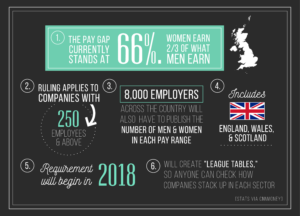The difference between hourly pay rates for men and women in Britain’s workforce fell to its lowest since records began 20 years ago, the country’s statistics agency said on Thursday.
 The typical male full-time employee in Britain earned 9.1 percent more than a full-time female employee, down from 9.4 percent a year earlier and the lowest since the survey started in 1997, when the gap was 17.4 percent.
The typical male full-time employee in Britain earned 9.1 percent more than a full-time female employee, down from 9.4 percent a year earlier and the lowest since the survey started in 1997, when the gap was 17.4 percent.
Pay differences have attracted significant public attention in Britain over the past year and from next year large businesses will be required to publish figures on them.
Prime Minister Theresa May said in July that the BBC needed to tackle the gap in pay between its top male and female presenters, after a report showed very high salaries paid to a handful of male stars.
The headline figure provided by the Office for National Statistics on Thursday does not compare men and women doing equivalent jobs with similar experience and qualifications.
Instead, the difference in median hourly pay partly reflects the fact that men are more likely to work in highly paid fields, such as managerial roles, while areas such as administration and caring have a mostly female workforce and lower average pay.
Age also plays a big role. The headline figures show little difference between the pay of typical male and female full-time employees aged between 20 and 40, with men earning on average just 2-3 percent more on a median basis.
However, the gap between men and women in their forties jumps to 14 percent and rises to 16 percent for full-time employees aged between 50 and 59.
“This is likely to be connected with patterns of return to work after having children, in particular any differences between men and women in timing and nature of returning to the labour market,” the ONS said.
The data shows women in their thirties who work part-time earn a significant premium over men, unlike at earlier ages – possibly reflecting women in relatively well-paid fields moving from full-time to part-time work after childbirth.
However, women who work part-time do not earn much more than part-time men if they are in their forties, and earn less in their fifties and sixties.
Thursday’s figures came as part of a broad annual survey of British wages, based on pay data reported by companies to tax authorities. They paint a similar picture on overall trends as the ONS’s less comprehensive monthly figures.
Pay in April 2017, the period covered by Thursday’s survey, was 2.2 percent a year higher in cash terms, the same growth as in 2016. However, adjusted for consumer price inflation pay was 0.4 percent lower than a year before and 4.7 percent below its peak in 2008, before the financial crisis.
The median full-time annual salary was 28,758 pounds ($37,975) before tax.
Kindly follow us on twitter:@AfricanVoice2












